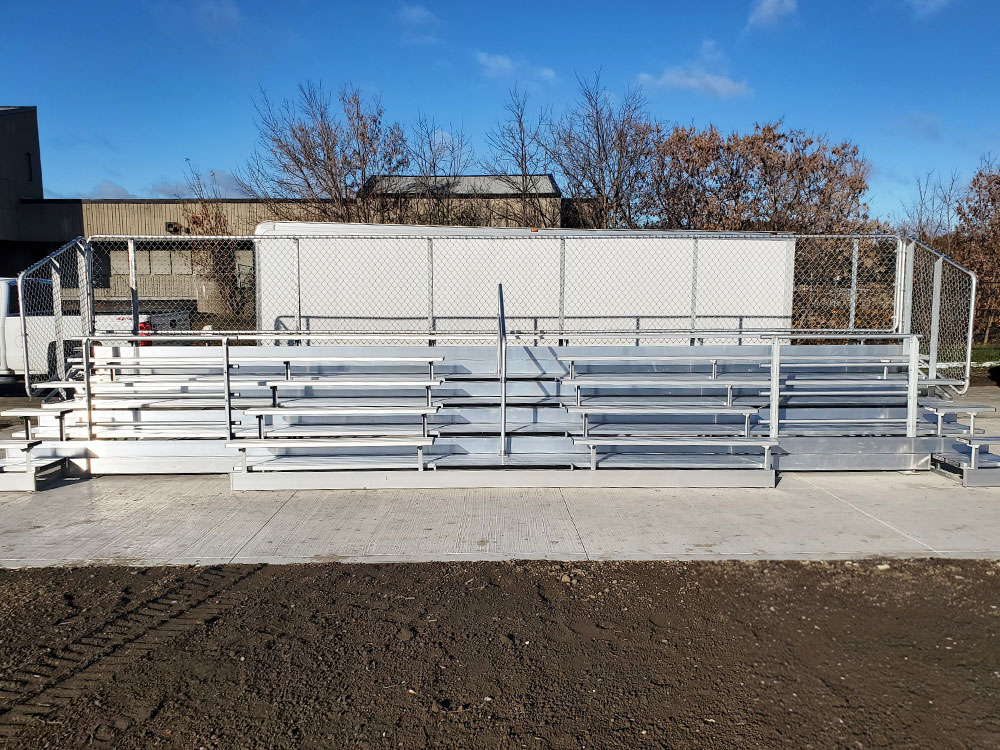Maybe it was a call, or perhaps a memo that landed on your desk. No matter how it was delivered, you were tasked with acquiring a new set of bleachers.
The good news is, you aren’t alone. While there are buyers that are well-versed in the world of aluminum spectator seating, there are also many that don’t have any experience at all.
When it comes to selecting a new bleacher, there are a few things to figure out before picking up the phone. Given that they come in different shapes, sizes and configurations, it’s important to have a general idea about what exactly you are looking for.
As such, here’s a few things that will catapult you on your way to finding the right bleacher system.
This is a big factor that ultimately determines what size of bleacher you can install. The first step would be determining what kind of space you are working with or have available. This is a quick, on-site measurement of the length and depth of the space intended for the bleacher.
In some cases, your facility may already have some sort of pad already in place. In cases of bleacher replacement projects, this is often the case. In the event of a new installation or site, an accurate measurement will be used to help us determine the right bleacher for the space.
Where possible, we encourage buyers to get an accurate measurement of the available space. This, along with capacity, helps us recommend the best bleacher for you.
This is an answer most people already know when they begin their bleacher buying journey. If it isn’t, be sure to give it some thought before exploring pricing. Once we know how many people we need to seat, we’ll use that and the measurements to find the right fit. This allows us to present a few different options to both maximize space and seating.
Many buyers are also able to work backwards with our easy-to-use formula. Using simple math, anyone can determine what size of bleachers their facility needs.
We recommend about 18” of space for an individual seat. Meaning for every 18” of space per seating platform, you should attribute one seat.
For illustration purposes we will use our 4-Tier Aluminum Bleachers (model: BL-4TB-12DR ). These bleachers measure at 144″ x 82″ x 38″ for a total of 576” of total seating space. Divide that number by our standard 18” measurement and you are looking at seating for about 32 people. This is an easy calculation to help you assess your seating needs.
This has become a major concern for many managers and operators over the past decade. With a number of regulatory changes, barrier-free seating is here to stay and something that should always be considered.
Whether you are looking to build ramps or wheelchair seating into an existing bleacher or ensuring that your new build is compliant, our team can design anything to suit your needs. From guardrails and ramps, to optimized sightlines and custom cutouts for wheelchairs, this is an important consideration for any new bleacher build.
When it comes to code compliance, selecting the right bleacher and manufacturer can often be the difference between a long-lasting seating solution and one that eventually becomes condemned.
With “catalog” bleachers being sold at discounted prices across the internet, it’s important to select a bleacher that meets or exceeds all applicable building and safety codes.
You’ve got questions, we’ve got answers. Here’s a quick selection of some of the most common questions we field on a daily basis.
Typically speaking, elevated bleachers are usually larger in size and are used when spectator visibility is a main concern. These elevated units offer a clear line of sight by eliminating visual distractions, such as passers-by, walls, barricades or other ground-level obstructions. Read more about the differences…
Tip and roll bleacher systems are your go-to choice when looking for a quick and versatile seating solution when only temporary seating is required. These bleacher systems are easily tipped up onto their swivel casters for easy movement and are equipped with caster brakes to keep the bleacher from rolling while in storage. View our tip and roll bleachers.
Rise height refers to the vertical measurement from the top of one bleacher seat to the top of the bleacher seat in the next row. Tread Depth refers to the depth or horizontal measurement of the front of a bleacher seat to the front of the bleacher seat in the next row.
This term refers to a piece of aluminum that is attached underneath the seats and behind spectators feet, which closes the open area between the seating plank and foot plank. Riser boards come in standard aluminum “mill finish” or can be coloured.
Canada – If the unit you are purchasing has a seat height anywhere in the unit of 48” or greater, typically guard railing is required for that unit at those points.
USA – If the unit you are purchasing has a seat height anywhere in the unit of 30” or greater, typically guard railing is required for that unit at those points.

Accessible bleacher with custom wheelchair cutouts and railings.

Two 5-row bleachers along sideline of football field.

10-row bleachers used at fair grounds for an agricultural society.

Two banks of custom 6-row bleachers along football field sideline.
If you can dream it, we can build it.